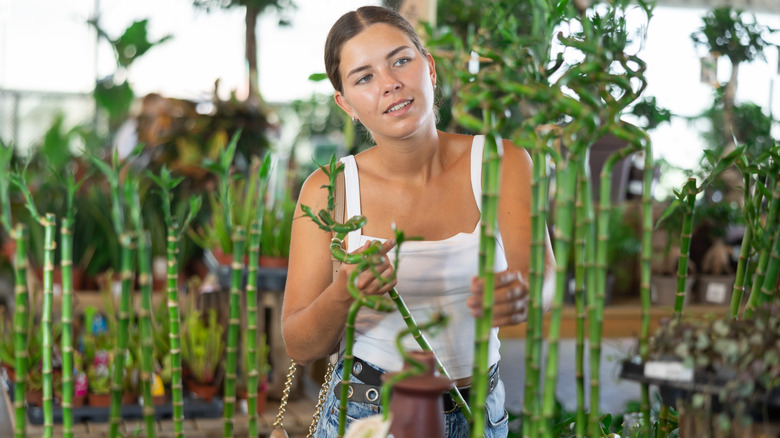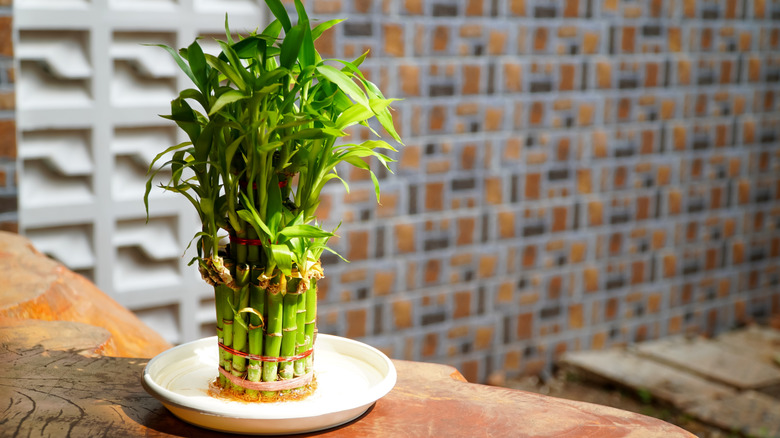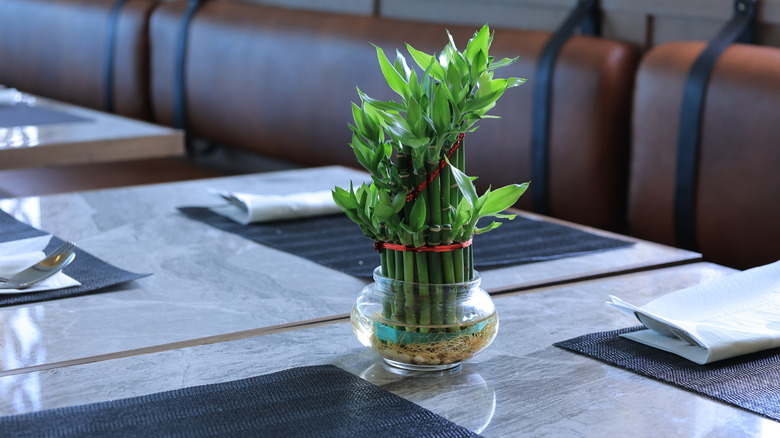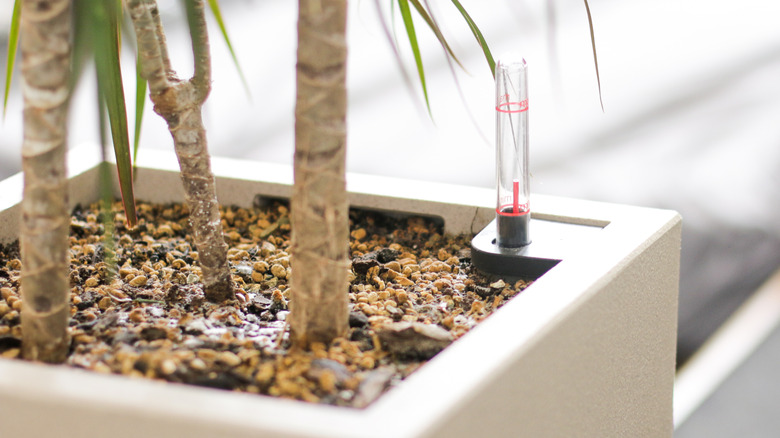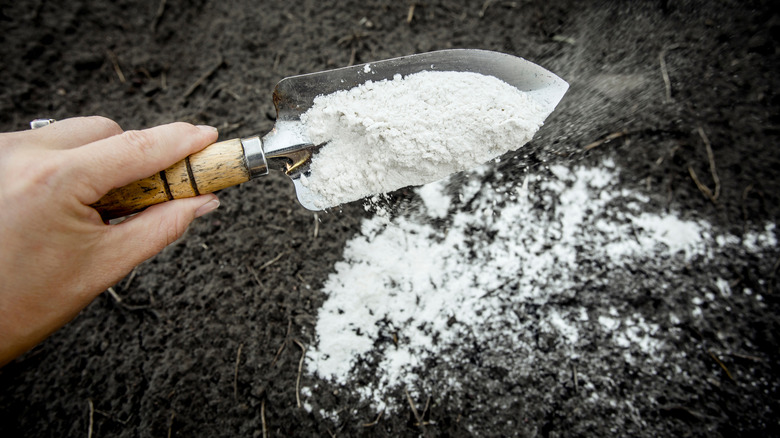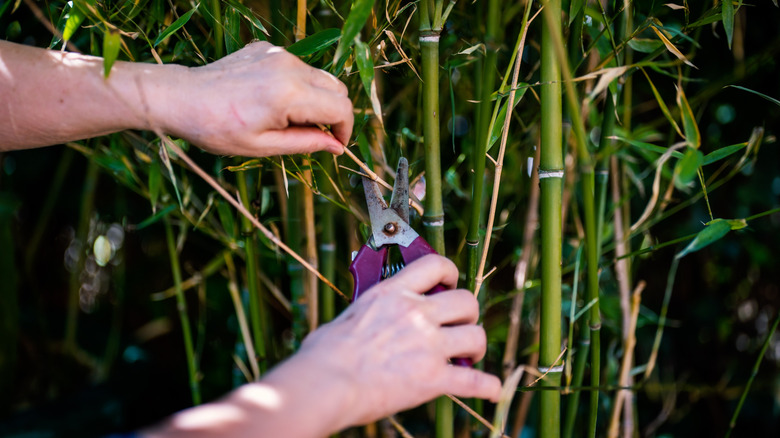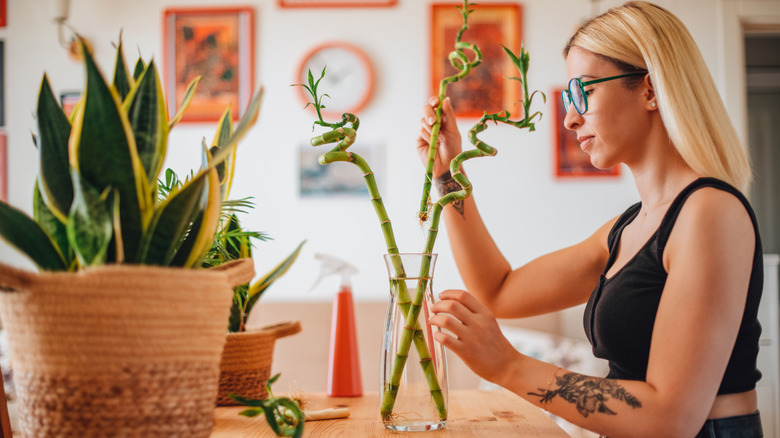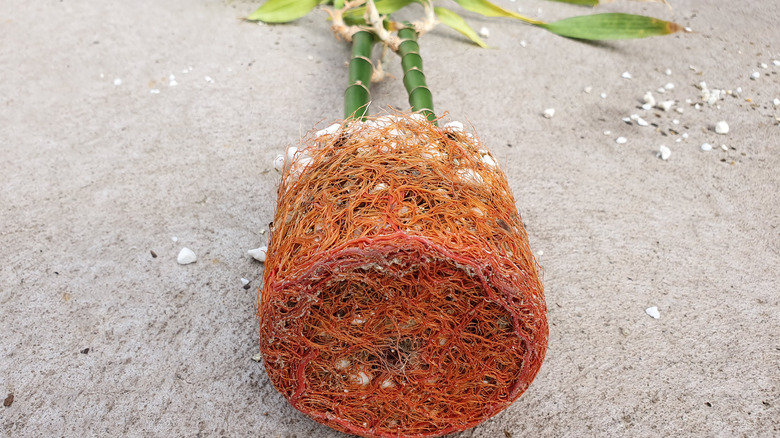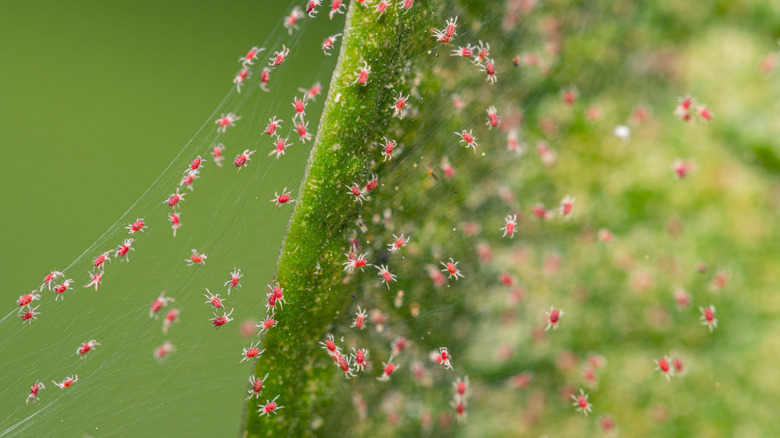How To Take Care Of Bamboo: Must-Know Tips For Happy And Healthy Plants
Bamboo holds the Guinness World Record for the fastest-growing plant, and some species can shoot up to nearly 3 feet in just one day. Its rapid growth rate makes it a favorite for quick privacy fences or attractive potted plants, but it requires somewhat specific care for it to truly thrive. Although bamboo can tolerate drought and is generally low-maintenance once it's established, there are a few mistakes you'll want to avoid as it grows. Additionally, potted plants, especially those grown indoors, typically require more care than bamboo growing in your yard.
While you need a bit of bamboo knowledge before planting it, the actual maintenance isn't too challenging — even if you're a beginner. When bamboo is properly maintained, it's pretty resilient and will show you clear signs if there are any issues. There are over 100 bamboo species in America to choose from, with some thriving in tropical climates and others you can grow even if you live in a colder area. Each type is a little different, so make sure to choose one that's suited to your region — and not an invasive. With the tips below, you'll be ready to plant and easily care for your own gorgeous bamboo, whether it's kept inside or growing outdoors.
Types of bamboo
When choosing a bamboo plant, first consider how you want it to look and grow in your space. There are two main categories of bamboo: clumping (pachymorphs) and running (leptomorphs). Clump-forming bamboo varieties spread slowly and their culms grow more closely together than running varieties, so they're considered the non-invasive option.
Runners can be extremely invasive, with culms that pop up spaced further apart and rapidly spread through underground rhizomes. Unless you regularly trim them or damage the growing tips, they'll spread indefinitely, taking up your backyard fast. These fast growers are much more difficult to manage and can easily outgrow a smaller yard or cause damage to neighboring landscapes. Unless you're certain you can keep up with it, choose a clumping variety of bamboo for in-ground planting and check its invasiveness status in your region.
Depending on the species, bamboo can grow to be 10 feet to over 100 feet tall. Spreader plants can escape containers, so opt for dwarf varieties when growing indoors. If using bamboo for landscaping, choose a cultivar that's suited for your area's climate, as some prefer tropical climates while others are more cold-hardy. No matter which type you have, you'll need to manage its growth when growing bamboo grown outdoors. The rhizomes will spread rapidly underground during warmer seasons, then new culms will typically emerge up from the roots around springtime. When you see a new shoot sticking out of the ground, you can manually remove it with pruning shears or stop its growth by mowing the area.
Choose the right location for your bamboo plants
Bamboo plants may look exotic, but they're relatively easy to care for when planted in the right location with the proper conditions. Most types prefer a spot in your home or garden where they can receive full sun to partial shade, and the placement will impact how well they grow. Some species of bamboo need the sun more than others and will have more vigorous growth when they get at least eight hours of sunshine, while others will happily grow in partially shaded areas. In hotter regions, many varieties will appreciate some afternoon shade to protect the leaves from the sunny afternoon rays. In addition to warm conditions, most bamboo species are humidity-loving plants, especially those native to the tropics and subtropics.
Although this species appreciates light, long periods of intense, direct sun can cause your bamboo to turn yellow or get sunburnt. If you notice yellowing or scorch marks, remove the damaged leaves and move your indoor plants to a window that receives bright, indirect light. Similarly, when growing outdoors, you'll need to prune the yellow leaves and relocate your bamboo to an area that's partially shaded or with dappled sun during peak hours. When choosing the right location in your yard, choose a spot that can accommodate bamboo's impressive heights. Because bamboo can grow dozens of feet tall, it's commonly used as a barrier plant or specimen plant in landscaping.
Is it better to keep your bamboo in water or soil?
Dwarf bamboo plants can be a little sensitive when it comes to water levels, so when growing indoors, it's best to plant them in a container with a lightweight, well-draining soil blend. If you've ever seen bamboo-like stalks growing in water at grocery stores or garden centers, you were probably looking at lucky bamboo (Dracaena sanderiana), which isn't a true bamboo. Also known as water bamboo, this asparagus family member has the same look. But unlike its alternative, it grows as easily in water as it does in soil.
Even with the best care and effort, growing true bamboo indoors can be tricky. If you're looking for a houseplant with a similar look without the demanding upkeep, lucky bamboo is a great low-maintenance alternative. To take care of lucky bamboo plants in water, be sure to use filtered or distilled water, as tap water can cause browning on the leaves. Additionally, too much fertilizer can damage these plants, and they will often need less liquid food than your other indoor species. One drop of fertilizer each month should be plenty. If you're growing it in soil instead of water, make sure to place it in a container with drainage holes and well-drained soil to prevent waterlogging.
The best potting soil for growing bamboo indoors
When growing true bamboo indoors, the soil you choose can make or break the health of the roots and the overall plant. Because bamboo is sensitive to water, it must be planted in light soil blends that provide good drainage. Soil that's too compact will restrict water and airflow to the roots, which your bamboo needs to absorb nutrients and grow. The lack of oxygen in dense soil blends can create a prime habitat for fungi and bacteria to thrive, leading to diseases like root rot, which can be fatal if left unchecked.
You can easily make a great lightweight soil mix for bamboo by combining equal parts light potting mix, peat moss, and perlite. Amendments like peat moss and perlite help break up the soil to provide more oxygen and improve airflow, giving the roots room to breathe. Their benefits are twofold; they help keep the soil moist while allowing excess water to drain through, keeping the bamboo's roots slightly moist without becoming waterlogged. Avoid generic gardening soil, as it tends to be too dense for bamboo roots. If keeping a pot with drainage holes over a saucer, adding a layer of gravel to the bottom will help keep the root tips from being submerged in the collected water.
How often to water your bamboo plants
Although established bamboo is relatively drought-tolerant, regular watering promotes even better growth. Younger plants with developing root systems need to be watered more frequently, typically for at least the first three to six months. Generally, depending on your soil, your plants will need water one to two times per week, whether manually or by rainfall. That said, you may need to increase the watering frequency during dry, hot periods. Pay extra close attention to potted bamboo, especially when grown outdoors. Container soil tends to dry out more quickly, so you'll likely need to water them more frequently.
Once your bamboo plant establishes its roots, you can cut back watering to once every 7 to 10 days, depending on your climate and the weather. While bamboo appreciates moist soil, it cannot withstand soggy conditions. Bamboo has a shallow root system, sitting about 2 to 18 inches beneath the soil, so you'll only need to give it an inch of water to fully hydrate it.
When growing bamboo in pots, water the plant once the top few inches of soil dry out, saturating it until water exits the drainage holes. If you're still unsure, lean toward underwatering rather than overwatering. If their roots sit in water, they'll likely rot and potentially kill the plant. Bamboo will tell you it's thirsty; its leaves will curl inward when the soil is too dry. To help maintain moisture, apply an even 2- to 3-inch layer of mulch around the base of your bamboo.
Choose the best fertilizer for your bamboo plants
Bamboo may look like a whimsical tree, but it's actually a type of grass in the Poaceae family. While most bamboo species can grow in soils with few nutrients, applying fertilizer once the growing season begins gives them a nutritional boost and makes bamboo grow faster. That said, you should only feed established bamboo plants, so hold off for the first year of growth. A surge of nutrients to young plants may cause fertilization root burn, shocking the bamboo and possibly leading to plant death. Instead, plant young bamboo in well-drained, nutrient-rich, acidic soil to give developing plants a strong foundation.
While you shouldn't feed young plants, you can give them a touch of extra nutrition by mixing organic matter like manure or compost into the soil. If your soil is more on the alkaline side, applying dolomitic limestone can help lower the pH to a level that bamboo prefers. Once your bamboo matures, most balanced N-P-K fertilizers will do the trick. However, because flowering isn't a concern, slow-release feeds higher in nitrogen and potassium but low in phosphorus, like an 18-6-12, are a better fit when choosing a bamboo plant fertilizer. Follow the instructions of your chosen fertilizer. Generally, you should feed outdoor plants at the beginning of the growing season and once again later in the year.
Tips for successfully pruning your bamboo plants
How much bamboo is too much bamboo in your yard? Luckily, that's a decision that's typically left up to you, as there aren't any strict rules to follow when pruning bamboo. That said, it's a good idea to cut off dead or damaged canes when you spot them. If you'd prefer a more airy feel, you can remove a few culms as you see fit. On the other hand, you can let them fill in more densely to grow a bamboo fence. While you don't have to prune regularly, giving your bamboo a trim when it starts to look dense will help prevent overcrowding and encourage better air circulation.
The best time to prune your bamboo is in fall through winter after the new shoots have matured. However, you can thin out a few culms at any time of the year as long as you don't remove more than one-third of healthy canes at a time. When thinning out dense growth, primarily remove canes that are five to seven years old.
The best way to cut down bamboo stalks is to focus on culms that seem the weakest or are overcrowded. Use a sharp, sanitized pair of shears when making any cuts, and cut as close to the soil as possible. If your bamboo gets too tall for your liking, you can snip off the tops of the plant. When adjusting the height, make sure to cut just above the node to prevent it from dying back.
How and when to propagate bamboo plants
If you want to add more bamboo to your collection, you can propagate rather than spend money on new plants. Because most species don't flower for 50 to 100 years (or produce viable seeds), dividing your plants is the easiest and most common method. While some species of bamboo can regrow from node cuttings, it can take months for them to take root and grow, and success rates widely vary, especially with thin-walled bamboo. That said, removing the culms won't harm the mother plant, so it's worth giving a try if you're pruning anyway.
Division is the easiest way to propagate bamboo, particularly if you have clumping types. Use a sharp spade to dig up a clump that has several culms and healthy roots. Running bamboo is a little trickier to divide due to its rhizomes, but it's not impossible. Similarly, you'll need to use a sharp tool to dig it up, but you'll also need to slice out a rhizome section that has buds or shoots attached. Once you've removed the bamboo from the ground, replant it as soon as possible, and keep the soil moist as it acclimates. Divide plants when the weather is warm, not overly hot or freezing. Generally, you should propagate by division in spring or early summer, though those in hot climates may have better luck in fall or winter.
Tips for repotting bamboo plants
Bamboo roots can grow quickly, so you'll need to upgrade to a bigger pot every 3 to 5 years. If it seems like the soil is drying out soon after watering it, it's a good indication that your bamboo needs a little more space. Additionally, some of the roots may start growing out of the drainage holes, and the pot may even crack if rhizomes are aggressively pushing against it. When in doubt, check the roots to see if they're tightly bound within the container. If so, it's time to switch pots.
Choose a pot that's about twice the size of its current container. Because the root system is somewhat shallow, opt for a pot that is wider than it is deep. Wider containers also give tall, heavy plants more stability, especially when strong gusts of wind attempt to tip them over. If you keep your bamboo outdoors, avoid thin plastic pots that can crack easily or may overheat from the sun. Instead, look for sturdy ceramic, wood, or thick plastic containers that can withstand the tough roots and are less affected by extreme weather conditions.
When it's time to repot, lay your bamboo on its side and gently remove the root ball. Add a layer of fresh soil to the bottom of the new pot at the same depth as its previous one. Place the root ball in the center and fill in the sides before covering it with dirt, and give it a good watering.
How to keep common pests away
Bamboo is generally pest-free, though it can still be susceptible to spider mites, scale, and other pests, especially when stressed. Bamboo spider mites are a common unwanted insect that you may see crawling on your bamboo plant. They're nearly impossible to see with the naked eye, but you'll know they've been nearby if you notice webbing on the underside of the leaves or yellow-brownish dots from where they've fed. In extreme cases, their damage can weaken the plant and make it struggle to grow and thrive.
Another pest you may encounter is scale, a sap-sucker that can cause yellowing of bamboo leaves or stunted growth. A large enough infestation can leave behind a build-up of honeydew that creates an ideal environment for sooty mold growth, a fungal disease that blocks sunlight, weakening the plant and stunting its growth.
When purchasing bamboo, thoroughly check the leaves and culms for signs of pests like webbing, a sticky residue, or off-looking discolorations. If pests target indoor bamboo once you've brought it home, quarantine it so the insects don't spread to and harm other plants. To get rid of spider mites, scale, and other insects on outdoor plants, a blast of soapy water is generally enough to knock them off and dissolve their protective coatings. One way to prevent outdoor infestations is to attract the natural predators of garden pests, like parasitoid wasps, by planting their favorite flowers nearby.
Common bamboo diseases and other reasons your plant may be dying
Bamboo is typically a hardy plant, but if it suddenly begins to decline, disease may be to blame. Rust is a relatively common fungal disease that affects bamboo and appears as rusty-colored red, orange, or brown blotches along the leaves. Plants are more susceptible in humid environments, where water sits on the surface for long periods of time.
Leaf spot is a fungal or bacterial disease that typically shows up as necrotic black spots caused by poor air circulation and excess moisture on the plant. Bamboo mosaic virus is another issue that affects bamboo, though it's somewhat rare. Symptoms of this disease include mottling that follows the leaf veins, yellow or brown streaks along the shoots or culms, premature leaf or culm drop, and in severe cases, plant death.
Inspect plants before purchase and routinely check them for signs of disease. To help infected plants bounce back, remove and dispose of any diseased or dying culms. Avoid overhead watering and sprinkler systems, since they leave water sitting on the plant and encourage fungal growth. Instead, aim your hose at the base to keep the foliage dry. If your indoor bamboo is struggling, check for signs of root rot, like yellowing or wilted leaves and mushy, dark roots. If your potted bamboo is dying, remove any soft or discolored roots, rinse the healthy ones, and repot the plant in fresh, well-drained soil.

